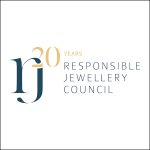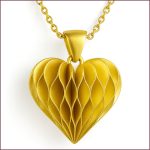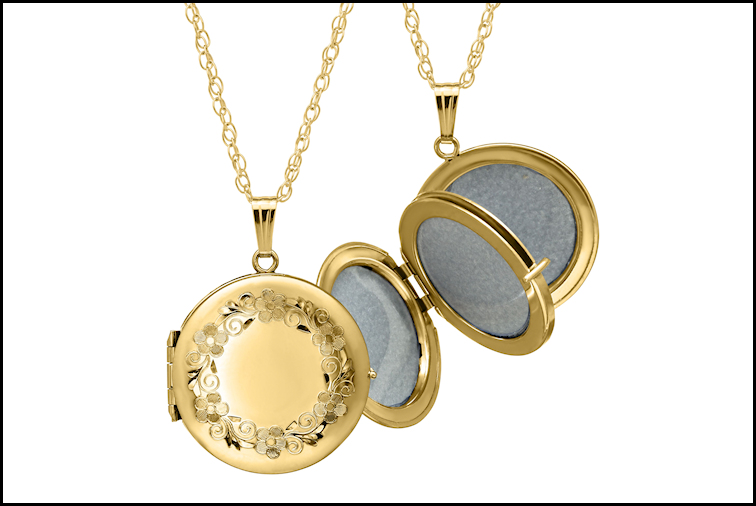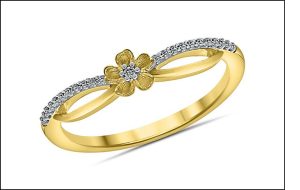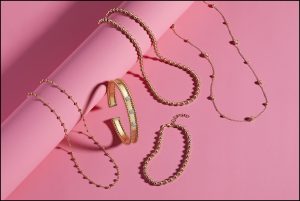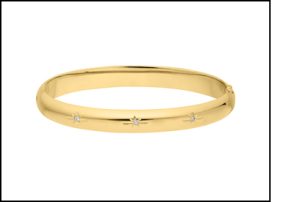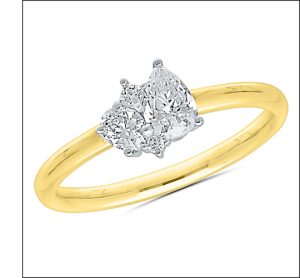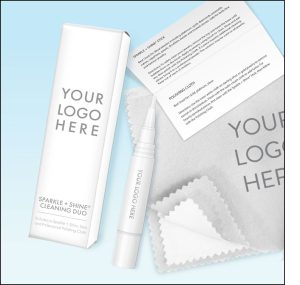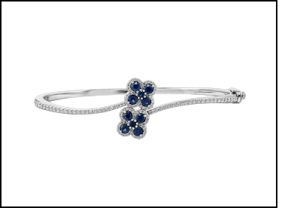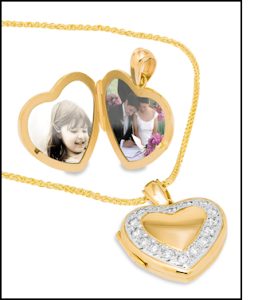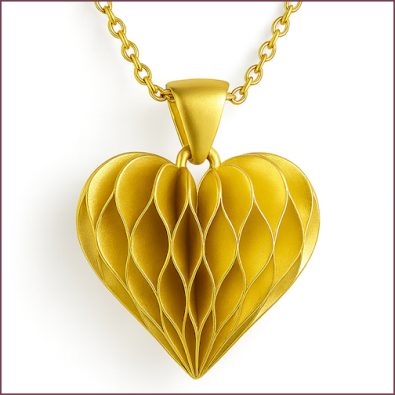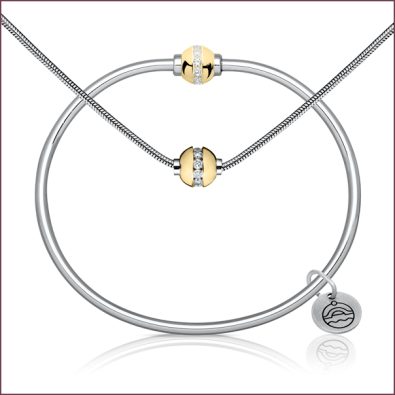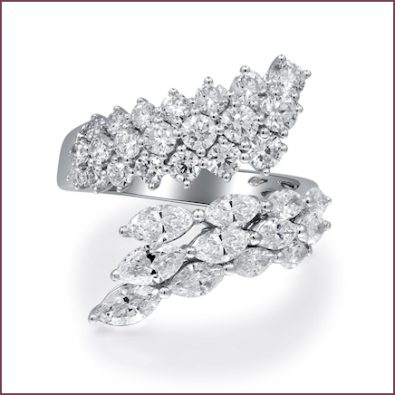Looking Ahead

A new year is upon us, and many have resolutions at the ready! Among jewelry store owners, preparation for 2025 will likely mirror 2024—research trends to stock, evaluate technology and tools to make merchants’ lives a little easier, and prepare for Valentine’s Day gifting occasions. There’s also another topic that’s top of mind: how to deal with the price of gold.
“The high price of gold will have a direct influence on how we develop gold jewelry,” maintains Valerie Fletcher, vice president of design and product development, ODI.
Like many manufacturers, Fletcher and her team are looking for creative ways to keep a lid on gold product costs, including offering vermeil jewels.
“Vermeil is a 2.5 mm gold plating over sterling silver which is substantial enough to look and feel like solid gold,” she says.
Other manufacturers reveal that even with high gold prices, the yellow metal remains desirable. Other jewelry trends include multi-stone pieces like Toi et Moi designs and cluster styles that create “diamond bouquet looks,” adds Fletcher.
And when February 14 rolls around, many a loved one will receive unique heart motifs and “vibrant colored stone jewelry,” says Surbhi Jain, marketing director, Shefi Diamonds. “Every piece is a translation of love in the form of jewelry.”
Tech Trends
Technology in the jewelry industry continues to evolve at a rapid pace! Fortunately for jewelers, some of your top suppliers are completely on top of tech trends that will benefit your business. From 3D printing jewelry to software that will make merchants’ lives easier, many of the industry’s most forward-thinking manufacturers are armed with tech tools that will aid your business.
With the price of gold at a record high, every maker is scrambling for ways to make the hikes more palatable to consumers. That’s not an easy task, especially when the cost of producing pieces skyrockets; sticker shock is an understatement.
ODI is managing high gold prices by utilizing DRC, a 3D-printed resin that goes directly to casting, skipping mold and model making.
“This allows you to design large-format pieces that are very thin and lightweight, with open mesh or filigree, that would not be possible using traditional casting,” explains Valerie Fletcher, vice president of product development. “The high price of gold … is compelling developers to use techniques that provide the biggest look and minimize gold loss.”
In fact, one of Fletcher’s favorite products is 3D-printed bracelets.
“Even the smallest, most intricate links can be assembled in CAD and printed in resin,” she adds. “Once supports are removed after casting, links are perfectly joined with no soldering, lasers, or seams.”
And given how pricey gold has gotten, many are turning more to platinum—the rarer metal that has become an incredible value in fine jewelry. The only sticking point is manufacturing with it; that can be more costly. That point is why ODI aims to minimize that barrier in 2025.
“We are making investments in state-of-the-art platinum casting equipment and testing the performance of various platinum alloys, with the goal of bringing the cost of platinum down to match with 14k white gold,” she says. “This will give our customers a superior product at a competitive price.”
Meanwhile, Royal Chain Group’s Phillip Gabriel Maroof, vice president of marketing and design, has some tech lifesavers for front-of-house operations. For example, in 2024, the company started transitioning to a new method of taking client orders, “moving away from paper forms to digital form using tablets,” he says. “This method is faster, more efficient, and allows us to see our sales at a glance and more easily to recognize order trends and what products are succeeding at specific shows.”
In 2025, Royal Chain will use new software to update its digital catalog experience, allowing its team to automate digital catalog uploads so all products are easily searchable and shoppable for customers online.
“With this investment, we plan to reach customers who rely on the catalog for browsing and discovering jewelry for their store more easily, so they have fewer steps to restocking their assortment,” he maintains.
Finally, Maroof firmly believes in the use of a strong email marketing platform. “It’s the most underrated piece of technology for retailers to utilize,” he says. And compared to social media, email is a direct line to customers who are interested in your products.
“Advancements in software allow you to automate messages, segment customers into ideal targets for specific messaging, and create an engaged community of repeat buyers.”
Hot Looks for 2025
As 2024 draws near, many are thinking ahead to next year’s hottest looks. To make next year’s must-haves, manufacturers consider current color trends, metal prices, and other aspects of best sellers to develop a compelling future-products plan.
Given that diamond prices (and desire) are still waning, colored gemstones have quickly become a preferred category. Shefi Diamonds will continue making its covetable lines, featuring them in flexible styles, textured jewels, and with enamel and colored diamonds. These, along with lightweight gold jewelry, “will be key materials for next year’s business,” says Surbhi Jain, marketing director. “We are definitely moving forward with multicolor sapphire jewelry as well.”
Royal Chain Group is incorporating more beaded looks in chain and in fashion-forward designs as well as electroform earrings due to the high price of gold. Gold costs are a source of concern to many as modest styles continue to climb in cost but not weight or embellishments—a reality that many are forced to confront.
Roger Forman, one of the owners of Marathon Company, maintains that merchants should consider 14k gold-filled jewelry. Marathon makes Kiddie Kraft jewelry for children as well as styles for adults.
“[Gold fill] meets a price-point need that solid gold jewelry simply cannot,” he insists. “Plus, 14k gold-filled jewelry has been around for centuries and is a great substitute for solid gold.” Marathon also makes 14k gold and sterling silver jewelry.
The firm has been making 14k gold-filled jewelry since 1897 in its factory in Attleboro, Mass. Forman explains that there are some important distinctions to make between gold-filled jewelry and gold-plate or vermeil jewelry. Namely, gold fill has more gold in it.
A USA industry standard legally requires 1/20th, or 5% pure gold by weight in 14k gold fill.
“It’s a strictly regulated process that involves pressure bonding multiple layers of solid 14k gold with extreme heat over a core of high-quality jeweler’s brass, resulting in a durable, quality real gold product,” he says.
While the total weight of the material is just 5% 14k gold, all the gold is on the surface, creating a durable long-lasting layer, unlike gold plating, which is more a film than a tangible layer and is often measured in mils (or millionths of an inch). Also, the standards for 14k gold fill are strictly regulated, while the standards for gold plate “encompass a broad range of thicknesses, so you can’t be sure how much gold is in the plated layer,” he continues. “[Gold fill] will not flake off and is a great option for people with sensitive skin.”
Alternatively, ODI is banking on platinum and mined diamonds to move in 2025.
“Both are the epitome of beauty, rarity, and value,” says Valerie Fletcher, vice president of design and product development. “You can mimic them with lab-grown stones and rhodium plating, but for important moments and milestones, these are the real deal.”
ODI has certainly not stopped offering karat gold—“It continues to be very strong,” she says—but is offering petite hoop earrings, dainty rings, and delicate necklaces in gold (and platinum). She calls these looks “affordable luxury.”
“Consumers are more price conscious, but they still want to celebrate achievements and occasions with something special,” she adds.
And while products from The Kingswood Company aren’t affected by gemstone and metals trends, the firm’s vice president of sales and marketing knows that their jewelry cleaners are an equally valuable part of every store’s inventory mix.
“Jewelry brands do not need to price their care products to compete with big box retailers,” explains Pam Waclawski. “Our jewelry retailers want to offer elevated products at higher price points, which luxurious and custom products support.”
Valentine’s Day Delights
With Valentine’s Day approaching, now is the perfect time to stock up giftable items for sweethearts (if you haven’t already placed orders). Hearts are an obvious jewelry motif for Valentine’s Day, but they’re certainly not the only symbol of love to gift. Others include angels, wings, initials, infinity symbols, birthstones, love knots, and more.
Shefi Diamonds offers nearly every item mentioned above, with the addition of charms and stackable designs. To make pieces more attainable, the brand has a selection of lighter-weight gold styles like hoops and bangles that retail between $250 and $500.
And just because hearts are a predictable design choice doesn’t mean they’re dull! Executed in modern silhouettes, they’re as covetable as any other trend. In fact, hearts have been riding a wave of popularity among high-end jewelry designers for about six years now, and consumers’ affinity for them shows no sign of stopping.
Perhaps this is why Shefi offers lightweight karat gold heart-silhouette hoops, and the Royal Chain Group offers puffy heart motifs on bracelets, necklaces, and earrings. Polished textures make Royal Chain’s hearts look “playful,” according to Phillip Gabriel Maroof, vice president of marketing and design.
“We’ve also introduced a new series of Phillip Gavriel 18-inch pendants featuring colorful gemstones for Valentine’s Day under the Popcorn collection,” he adds. “For the new ‘Puffed Hearts,’ we’re offering these styles in both all sterling silver and 14k-gold-plated silver to provide more options for our retailers and to create luxurious, trendy products at more accessible price points for customers.”
Roger Forman, one of the owners of Marathon Company, insists that his brand’s heart-shape locket is its most iconic piece of jewelry for Valentines Day and other special occasions. In fact, Marathon even has an online tool called Locket Studio that makes it easy to insert perfectly sized photos into them.
“The locket collection includes hand-engraved, embossed, diamond- and gemstone-accented and engravable styles in round, heart, and oval shapes,” says Forman. “These can hold two to four images and are offered in all metal types—14k gold, sterling silver, and 14k gold fill to meet all customers’ budgets.”
Marathon says that while lockets have been cherished through the ages for holding a loved one’s image close to the heart, locket-wearing today is a growing trend among younger generations.
“Not only as a look—lockets are classic, versatile, and nostalgically romantic—but they have been adopted as aspirational pieces, too,” he notes.
Marathon’s Locket Studio is a free tool that customers can use to create their own special design to place inside their locket. Once clients make their locket purchase in store, they are given a Marathon code to enter on the site. Alternatively, they can also search shapes and sizes online to find the one they purchased or desire.
“Upload an image, crop it or rotate it as needed, and Locket Studio presents five images on a 4-inch by 6-inch page that is ready to print on photographic paper and cut to fit,” adds Forman.
